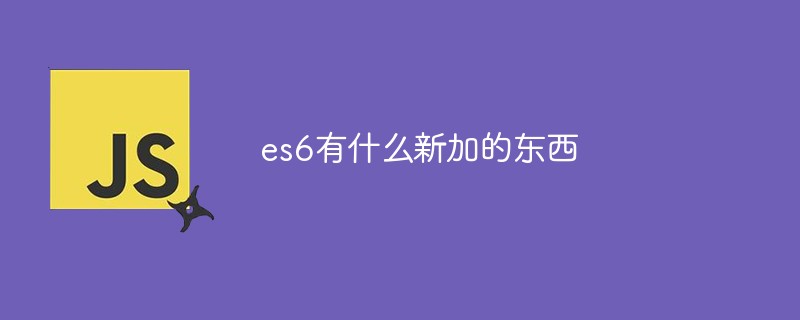es6有什麼新加的東西
es6新增的特性:1、用const和let宣告變量,兩個變數都為區塊級作用域;2、模板字串,語法“`字串`”,可使字串拼接更簡潔;3、箭頭函數,可很好解決this指向問題;4、延展操作符,將可迭代物件展開到其單獨的元素中;5、模組化等。

本教學操作環境:windows7系統、ECMAScript 6版、Dell G3電腦。
ECMAScript 6(ES6) 目前基本上成為業界標準,它的普及速度比ES5 要快很多,主要原因是現代瀏覽器對ES6 的支援相當迅速,尤其是Chrome 和Firefox 瀏覽器,已經支援ES6 中絕大多數的特性。
下面逐一為大家詳解常用的ES6新特性:
1.不一樣的變數宣告:const和let
在之前JS是沒有區塊級作用域的,const與let填補了這方便的空白,const與let都是區塊級作用域。
ES6建議使用let宣告局部變量,相較於先前的var(無論宣告在何處,都會被視為宣告在函數的最頂端) let和var聲明的區別:
var x = '全局变量';
{
let x = '局部变量';
console.log(x); // 局部变量
}
console.log(x); // 全局变量let表示聲明變量,而const表示聲明常數,兩者都為塊級作用域;const 聲明的變量都會被認為是常數,意思是它的值被設定完成後就不能再修改了:
const a = 1 a = 0 //报错
如果const的是一個對象,對象所包含的值是可以被修改的。抽像一點兒說,就是物件所指向的位址沒有變就行:
const student = { name: 'cc' }
student.name = 'yy';// 不报错
student = { name: 'yy' };// 报错有幾個點要注意:
- let 關鍵字宣告的變數不具備變數提升(hoisting)特性
- let 和const 宣告只在最靠近的一個區塊中(花括號內)有效
- 當使用常數const 宣告時,請使用大寫變量,如:CAPITAL_CASING
- const 在宣告時必須被賦值
#2.模板字串
在ES6之前,我們往往這麼處理模板字串: 透過「\」和「」來建構模板
$("body").html("This demonstrates the output of HTML \
content to the page, including student's\
" + name + ", " + seatNumber + ", " + sex + " and so on.");而對ES6來說
基本的字串格式化。將表達式嵌入字串中進行拼接。用${}來界定;
ES6反引號(``)直接搞定;
ES6支援模板字串,使得字串的拼接更加的簡潔、直覺。
$("body").html(`This demonstrates the output of HTML content to the page,
including student's ${name}, ${seatNumber}, ${sex} and so on.`);3.箭頭函數(Arrow Functions)
#這是ES6中最令人興奮的特性之一。 =>不只是關鍵字function的簡寫,它也帶來了其它好處。箭頭函數與包圍它的程式碼共用同一個this,能幫你很好的解決this的指向問題。有經驗的JavaScript開發者都熟悉諸如var self = this;或var that = this這種引用外圍this的模式。但藉助=>,就不需要這種模式了。
箭頭函數最直觀的三個特點。
- 不需要function 關鍵字來建立函數
- 省略return 關鍵字
- 繼承目前上下文的this 關鍵字
// ES5
var add = function (a, b) {
return a + b;
};
// 使用箭头函数
var add = (a, b) => a + b;
// ES5
[1,2,3].map((function(x){
return x + 1;
}).bind(this));
// 使用箭头函数
[1,2,3].map(x => x + 1);細節:當你的函數有且僅有一個參數的時候,是可以省略掉括號的。當你函數回傳有且僅有一個表達式的時候可以省略{} 和return;
4. 函數的參數預設值
在ES6之前,我們往往這樣定義參數的預設值:
// ES6之前,当未传入参数时,text = 'default';
function printText(text) {
text = text || 'default';
console.log(text);
}
// ES6;
function printText(text = 'default') {
console.log(text);
}
printText('hello'); // hello
printText();// default#5.延展運算子(Spread operator)
延展操作符 …是ES6中引入的,將可迭代對象展開到其單獨的元素中,所謂的可迭代對象就是任何能用for of循環進行遍歷的對象,例如:陣列、字串、Map 、Set 、DOM節點等。
延展運算子...可以在函數呼叫/陣列建構時, 將陣列表達式或string在語法層級展開;還可以在建構物件時, 將物件運算式按key-value的方式展開。
當被用於迭代器中時,它是一個Spread 運算子:
function foo(x,y,z) {
console.log(x,y,z);
}
let arr = [1,2,3];
foo(...arr); // 1 2 3當被用於函數傳參時,是一個Rest 運算子:當被用於函數傳參時,是一個Rest 操作符:
function foo(...args) {
console.log(args);
}
foo( 1, 2, 3, 4, 5); // [1, 2, 3, 4, 5]6.二進位和八進位字面量
ES6 支援二進位和八進制的字面量,通過在數字前面添加0o 或者0O 即可將其轉換為八進制值:
let oValue = 0o10; console.log(oValue); // 8 let bValue = 0b10; // 二进制使用 `0b` 或者 `0B` console.log(bValue); // 2
7.對象和數組解構
// 对象
const student = {
name: 'Sam',
age: 22,
sex: '男'
}
// 数组
// const student = ['Sam', 22, '男'];
// ES5;
const name = student.name;
const age = student.age;
const sex = student.sex;
console.log(name + ' --- ' + age + ' --- ' + sex);
// ES6
const { name, age, sex } = student;
console.log(name + ' --- ' + age + ' --- ' + sex);
ES6 允許在物件中使用super 方法:var parent = {
foo() {
console.log("Hello from the Parent");
}
}
var child = {
foo() {
super.foo();
console.log("Hello from the Child");
}
}
Object.setPrototypeOf(child, parent);
child.foo(); // Hello from the Parent
// Hello from the Child
let letter = ['a', 'b', 'c'];
letter.size = 3;
for (let letter of letters) {
console.log(letter);
}
// 结果: a, b, cfor...in 用来遍历对象中的属性:
let stu = ['Sam', '22', '男'];
stu.size = 3;
for (let stu in stus) {
console.log(stu);
}
// 结果: Sam, 22, 男10.ES6中的类
ES6 中支持 class 语法,不过,ES6的class不是新的对象继承模型,它只是原型链的语法糖表现形式。
函数中使用 static 关键词定义构造函数的的方法和属性:
class Student {
constructor() {
console.log("I'm a student.");
}
study() {
console.log('study!');
}
static read() {
console.log("Reading Now.");
}
}
console.log(typeof Student); // function
let stu = new Student(); // "I'm a student."
stu.study(); // "study!"
stu.read(); // "Reading Now."类中的继承和超集:
class Phone {
constructor() {
console.log("I'm a phone.");
}
}
class MI extends Phone {
constructor() {
super();
console.log("I'm a phone designed by xiaomi");
}
}
let mi8 = new MI();extends 允许一个子类继承父类,需要注意的是,子类的constructor 函数中需要执行 super() 函数。 当然,你也可以在子类方法中调用父类的方法,如super.parentMethodName()。 在 这里 阅读更多关于类的介绍。
有几点值得注意的是:
- 类的声明不会提升(hoisting),如果你要使用某个 Class,那你必须在使用之前定义它,否则会抛出一个 ReferenceError 的错误
- 在类中定义函数不需要使用 function 关键词
11、模块化(Module)
ES5不支持原生的模块化,在ES6中模块作为重要的组成部分被添加进来。模块的功能主要由 export 和 import 组成。每一个模块都有自己单独的作用域,模块之间的相互调用关系是通过 export 来规定模块对外暴露的接口,通过import来引用其它模块提供的接口。同时还为模块创造了命名空间,防止函数的命名冲突。
导出(export)
ES6允许在一个模块中使用export来导出多个变量或函数。
导出变量
//test.js export var name = 'Rainbow'
心得:ES6不仅支持变量的导出,也支持常量的导出。
export const sqrt = Math.sqrt;//导出常量
ES6将一个文件视为一个模块,上面的模块通过 export 向外输出了一个变量。一个模块也可以同时往外面输出多个变量。
//test.js
var name = 'Rainbow';
var age = '24';
export {name, age};导出函数
// myModule.js
export function myModule(someArg) {
return someArg;
}导入(import)
定义好模块的输出以后就可以在另外一个模块通过import引用。
import {myModule} from 'myModule';// main.js
import {name,age} from 'test';// test.js心得:一条import 语句可以同时导入默认函数和其它变量。
import defaultMethod, { otherMethod } from 'xxx.js';
【相关推荐:javascript视频教程、web前端】
以上是es6有什麼新加的東西的詳細內容。更多資訊請關注PHP中文網其他相關文章!

熱AI工具

Undresser.AI Undress
人工智慧驅動的應用程序,用於創建逼真的裸體照片

AI Clothes Remover
用於從照片中去除衣服的線上人工智慧工具。

Undress AI Tool
免費脫衣圖片

Clothoff.io
AI脫衣器

AI Hentai Generator
免費產生 AI 無盡。

熱門文章

熱工具

記事本++7.3.1
好用且免費的程式碼編輯器

SublimeText3漢化版
中文版,非常好用

禪工作室 13.0.1
強大的PHP整合開發環境

Dreamweaver CS6
視覺化網頁開發工具

SublimeText3 Mac版
神級程式碼編輯軟體(SublimeText3)

熱門話題
 async是es6還是es7的
Jan 29, 2023 pm 05:36 PM
async是es6還是es7的
Jan 29, 2023 pm 05:36 PM
async是es7的。 async和await是ES7中新增內容,是對於非同步操作的解決方案;async/await可以說是co模組和生成器函數的語法糖,用更清晰的語意解決js非同步程式碼。 async顧名思義是「非同步」的意思,async用於聲明一個函數是異步的;async和await有一個嚴格規定,兩者都離不開對方,且await只能寫在async函數中。
 es5和es6怎麼實現陣列去重
Jan 16, 2023 pm 05:09 PM
es5和es6怎麼實現陣列去重
Jan 16, 2023 pm 05:09 PM
es5中可以利用for語句和indexOf()函數來實現數組去重,語法“for(i=0;i<數組長度;i++){a=newArr.indexOf(arr[i]);if(a== -1){...}}」。在es6中可以利用擴充運算子、Array.from()和Set來去重;需要先將陣列轉為Set物件來去重,然後利用擴充運算子或Array.from()函數來將Set物件轉回數組即可。
 PHP 8.3發布:新功能一覽
Nov 27, 2023 pm 12:52 PM
PHP 8.3發布:新功能一覽
Nov 27, 2023 pm 12:52 PM
PHP8.3發布:新功能一覽隨著技術的不斷發展和需求的不斷變化,程式語言也不斷更新和改進。作為一種廣泛應用於網頁開發的腳本語言,PHP一直在不斷進步,為開發者提供更強大和高效的工具。最近發布的PHP8.3版本帶來了許多期待已久的新功能和改進,以下讓我們來看看這些新特性的一覽。非空屬性的初始化在過去的PHP版本中,如果一個類別的屬性沒有明確賦值,它的值
 es6 import會變數提升嗎
Jan 18, 2023 pm 07:44 PM
es6 import會變數提升嗎
Jan 18, 2023 pm 07:44 PM
ES6 import會產生變數提升的現象。變數提升是將變數宣告提升到它所在作用域的最開始的部分。 js要經歷編譯跟執行階段,在編譯階段的時候,會蒐集所有的變量聲明並且提前聲明變量,而其他的語句都不會改變他們的順序,因此,在編譯階段的時候,第一步就已經執行了,而第二部則是在執行階段執行到該語句的時候才執行。
 學習PHP8的新特性,深入理解最新技術的指南
Dec 23, 2023 pm 01:16 PM
學習PHP8的新特性,深入理解最新技術的指南
Dec 23, 2023 pm 01:16 PM
深入解析PHP8的新特性,幫助您掌握最新技術隨著時間的推移,PHP程式語言一直在不斷演進和改進。最近發布的PHP8版本為開發者提供了許多令人興奮的新功能和改進,為我們的開發工作帶來了更多便利和效率。在本文中,我們將深入解析PHP8的新特性,並提供具體的程式碼範例,旨在幫助您更好地掌握這些最新的技術。 JIT編譯器PHP8引進了JIT(Just-In-Time)編
 es6怎麼判斷陣列裡總共有多少項
Jan 18, 2023 pm 07:22 PM
es6怎麼判斷陣列裡總共有多少項
Jan 18, 2023 pm 07:22 PM
在es6中,可以利用array物件的length屬性來判斷數組裡總共有多少項,即取得數組中元素的個數;該屬性可傳回數組中元素的數組,只需要使用「array.length」語句即可傳回表示數組物件的元素個數的數值,也就是長度值。
 es6回調地獄是什麼
Feb 14, 2023 pm 02:58 PM
es6回調地獄是什麼
Feb 14, 2023 pm 02:58 PM
在es6中,回呼地獄就是多層回呼函數相互嵌套,也就是回呼函數中嵌套回呼函數的情況;它是為了實現程式碼順序執行而出現的一種操作,它會造成我們的程式碼可讀性非常差,後期不好維護。 es6中使用promise來解決回調地獄的問題。
 es6怎麼將字串轉為大寫
Feb 15, 2023 am 11:56 AM
es6怎麼將字串轉為大寫
Feb 15, 2023 am 11:56 AM
轉換方法:1、使用toUpperCase()函數將字串轉換為大寫,語法「string.toUpperCase()」;2、使用toLocaleUpperCase()函數將字串轉換為大寫,語法「string.toLocaleUpperCase()」;3 、利用slice()、toUpperCase()、toLowerCase()函數和字串拼接符「+」來設定首字母大寫。






